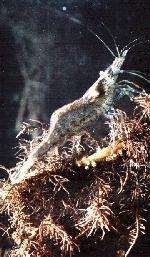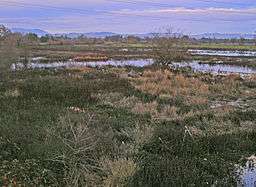Syncaris pacifica
| Syncaris pacifica | |
|---|---|
 | |
| Scientific classification | |
| Kingdom: | Animalia |
| Phylum: | Arthropoda |
| Subphylum: | Crustacea |
| Class: | Malacostraca |
| Order: | Decapoda |
| Infraorder: | Caridea |
| Family: | Atyidae |
| Genus: | Syncaris |
| Species: | S.pacifica |
| Binomial name | |
| Syncaris pacifica Holmes, 1895 | |
Syncaris pacifica is an endangered species of freshwater shrimp in the family Atyidae that occurs only in a limited range within the northern San Francisco Bay Area, California, USA. Specifically, this species occurs only in 17 stream segments within Sonoma, Napa and Marin Counties. This species is often translucent to transparent, with both sexes capable of considerable coloration altering, as a sophisticated form of camouflage.[2] This decapod is commonly known as California freshwater shrimp, and is the only decopod shrimp in California that occurs in non-saline waters.
S. pacifica is one of only four members of the family Atyidae in North America. Genetic studies have been conducted to compare specimens of Syncaris pacifica from various drainages, with the results showing a variety of well-defined genetic variations within these populations.[3] The species has a superficial appearance to its better known marine relatives, and may attain a body length of about 5 cm.
Morphology
Syncaris pacifica is a one-legged crustacean that employs a two-pronged approach to camouflage: it uses a technique of translucency coupled with strategically placed chromatophores, which occur internally as well as on the surface. As a result, the clustered color-producing cells combined with translucency masks the body outline and blends the organism to its subsurface environment.[2] Consequently, an illusion is presented that S. pacifica are submerged, decaying vegetation. California freshwater shrimp move quite torpidly and are practically invisible among water column leaf and twig substrates, and among the slender, exposed, living roots of riparian vegetation along undercut stream banks.[4]
Males and juveniles are always translucent or transparent, while coloration of the sometimes translucent females ranges from dark brown to purple, some with a broad tan dorsal band. Females may change rapidly from this very dark cryptic color to nearly transparent with diffuse chromatophores. Moreover, females are typically longer and deeper bodied than males.
All Atyidae family members can be distinguished from other shrimp by their overall length as well as the extent length of their pincer-like claws and manifestation of terminal bristles (setae) at the tips of the first and second chelae. A short spine above the eye and the angled articulation of the second chelae with the carpus differentiate the California freshwater shrimp from other shrimp that occur California.[2] A carapace length (reckoned from eye socket to tail-tip) of slightly more than five centimeters can be attained.
Range

The precise historic distribution of Syncaris pacifica is not known, since geologic and climatic changes since the early Quaternary Period have significantly altered river courses of the Northern California coast. Historically, Syncaris pacifica may have occurred as far north as the Klamath River, but reductions of habitat, especially from overgrazing of cattle, along with chemical water pollution has greatly diminished the present range to 17 stream segments in Sonoma, Napa and Marin Counties. These habitat stream segments are sometimes separated by degraded portions of a given creek, effectively leading to a fragmented population. Occurrence is restricted to perennial streams below 100 meters above sea level in elevation and of gradient less than one percent.[5] The stream segments can be grouped as follows:
- Certain stream segments which drain directly to the Pacific Ocean, including Tomales Bay, in Marin and Sonoma Counties
- Sonoma Creek, lower Napa River, Tolay Creek and Petaluma River, all of which drain to the San Pablo Bay
- Certain lower tributaries of the Russian River including the Laguna de Santa Rosa and certain of its tributaries such as Blucher Creek[6]
Habitat and behavior

California freshwater shrimp prefer streams that have water flowing year round with predominately low gradient flows.[7] In the summer months with little precipitation and surface runoff the flow rates can be very low with larger pools but they characteristically transport heavy runoff during the rainy winter season.
As a slow moving species S. pacifica feeds on decomposing vegetation and other detritus, consuming minute diverse particles conveyed by currents to downstream pools. As the water slows, the particles are filtered by the fine network of exposed roots from trees, such as from willows and alders. The California freshwater shrimp merely brush up the food with tufts at the tips of their small claws, and lift to their mouths the collected morsels. Colonized by algae, bacteria, fungi, and microscopic animals, the particle agglomerates are quite nutritious. Although most species of shrimp walk slowly about the roots as they feed, S. pacitica will undertake short swimming bursts to obtain particularly desirable items.[8]
Breeding occurs once per annum during the autumn. Adults attain sexual maturity by the end of their second summer. A female can be expected to generate approximately 50 to 120 eggs per breeding season, which remain attached to the mother for the entire winter. Studies on other family members suggest a lifespan for this species of several years.[9]
Conservation
Syncaris pacifica and associated native aquatic species
- Protect and manage S. pacifica populations and habitat once the threats are removed and restoration has been completed
- Monitor and evaluate S. pacifica habitat conditions and populations
- Assess effectiveness of various conservation efforts
- Conduct research on the biology of the species
- Restore and maintain viable S. pacifica populations at extirpated locations
- Increase public awareness and involvement in the protection of S. pacifica and native cohabiting species
- Assess effects of various conservation efforts on cohabiting native species
- Assemble a S. pacifica recovery team
There are individual efforts occurring in various stream segments, one of the most notable being a grassroots conservation program to restore over 1,400 meters (4,600 ft) of Stemple Creek by students at Brookside School in Marin County. In this case students raised money, lobbied legislators and succeeded in obtaining grant funds to prevent cattle grazing within the creek, one of the greatest habitat threats.[10][11]
Although a new location of Syncaris pacifica was found in the 1990s at Olema Creek, the general trend for the population of this organism is decline. For example, 1999 surveys in Marin County found fewer individuals present than a comparable 1997 survey.[12]
See also
References
- ↑ Inland Water Crustacean Specialist Group (1996). "Syncaris pacifica". IUCN Red List of Threatened Species. Version 2009.2. International Union for Conservation of Nature. Retrieved May 25, 2010.
- 1 2 3 "Species account for California freshwater shrimp, Syncaris pacifica". United States Fish and Wildlife Service Office, Sacramento Division. Archived from the original on April 1, 2007.
- ↑ Kevin J. Roe. "Systematics, evolution, & conservation: North American Atyid Shrimp".
- ↑ Habitat Requirements of the Endangered California Freshwater Shrimp in Streams on the Point Reyes National Seashore and Golden Gate National Recreational Area, United States Geological Survey
- ↑ L. L. Eng (1981). Distribution, life history, and status of the California freshwater shrimp, Syncaris pacifica (Holmes). California Department of Fish and Game. Inland Fisheries Endangered Species Program Special Publication 81-1.
- ↑ "Our Endangered California Freshwater Shrimp". Blucher Creek Watershed Council.
- ↑ "California Freshwater Shrimp, Syncaris pacifica". California Department of Fish and Game.
- ↑ Larry Serpa (1996). "The California freshwater shrimp: A ghost-like crustacean we can't afford to lose". Tidelines. United States Fish & Wildlife Service. 16 (2): 1–3.
- ↑ G. Fryer (1977). "Studies on the functional morphology and ecology of the atyid prawns of Dominica". Philosophical Transactions of the Royal Society B. 277 (952): 57–129. doi:10.1098/rstb.1977.0007. PMID 850693.
- ↑ Daniel Strait. "A Shrimp Spawns Partnerships". Endangered Species Bulletin. 21 (1). Archived from the original on May 9, 2007.
- ↑ Daniel Strait (January 2005). "Partnerships for a shrimp". United States Fish and Wildlife Service. Retrieved June 26, 2011.
- ↑ "1999 Survey for California freshwater shrimp at five Marin County locations" (PDF).
